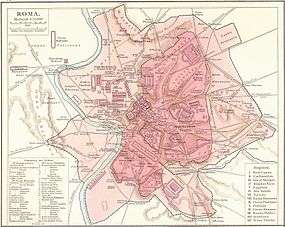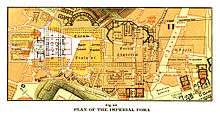Trajan's Forum
| Trajan's Forum | |
|---|---|
 | |
| Location | IV Templum Pacis |
| Built in | 106–112 AD |
| Built by/for | Emperor Trajan |
| Type of structure | Imperial fora |
| Related | Quirinal Hill, Capitoline Hill , Trajan's Column, Trajan's Market |
 Trajan's Forum | |
Trajan's Forum (Latin: Forum Traiani) was the last of the Imperial fora to be constructed in ancient Rome.[1] The architect Apollodorus of Damascus oversaw its construction.
History
This forum was built on the order of the emperor Trajan with the spoils of war from the conquest of Dacia, which ended in 106.[1] The Fasti Ostienses state that the Forum was inaugurated in 112, while Trajan's Column was erected and then inaugurated in 113.
To build this monumental complex, extensive excavations were required: workers eliminated the sides of the Quirinal and Capitoline (Campidoglio) Hills, which closed the valley occupied by the Imperial forums toward the Campus Martius.
It is possible that the excavations were initiated under Emperor Domitian, while the project of the Forum was completely attributed to the architect Apollodorus of Damascus,[1] who also accompanied Emperor Trajan in the Dacian campaign.
During the time of the construction, several other projects took place: the construction of the Markets of Trajan,[1] and the renovation of the Caesar's Forum (where the Basilica Argentaria was built) and the Temple of Venus Genetrix.
Structure
 | |
|
|
The Forum consisted of a vast portico-lined piazza measuring 300 metres (980 feet) long and 185 metres (607 feet) wide exedrae on two sides. The main entrance to the forum lay on the southern side, via a triumphal arch surmounted by a statue of Trajan in a six-horse chariot. The Basilica Ulpia lies at the north end of the piazza, which was cobbled with rectangular blocks of white marble and decorated by a large equestrian statue of Trajan. On either side of the piazza are markets, also housed by the exedrae.
North of the Basilica was a smaller piazza, with a temple dedicated to the deified Trajan on the far north side facing inwards. The position of - and very existence of - the temple dedicated to the deified Trajan is a matter of hotly contested debate among archaeologists, particularly clear in the ongoing debate between James E. Packer and Roberto Meneghini.[2] Directly north of the Basilica Ulpia on either side of the forum were two libraries, one housing Latin documents and the other Greek documents. Between the libraries stood the 38-metre (125-foot) Trajan's Column.[1]
Constantius II, while visiting Rome in the year 357,[3] was amazed by the huge equestrian statue of Trajan and by the surrounding buildings:
But when he [Constantius II] came to the Forum of Trajan, a construction unique under the heavens, as we believe, and admirable even in the unanimous opinion of the gods, he stood fast in amazement, turning his attention to the gigantic complex about him, beggaring description and never again to be imitated by mortal men. So renouncing all hope of attempting anything of the kind, he said he wanted to imitate only Trajan's horse, set in the middle of the atrium, and with the emperor on its back. And prince Ormisda ... standing beside him, replied with pleasing wit: "First, emperor, command the construction of a stable like this, so that the horse you wish to have made can find as appropriate a setting as that we have before our eyes."
The imperial visit and the landmarks of the forum were described by historian Ammianus Marcellinus.

In modern times only a section of the markets and the column of Trajan remain. A number of columns which historically formed the Basilica Ulpia remained on site, and have been re-erected. The construction of the Via dei Fori Imperiali in 1933 covered a number of these columns, which remain visible under the arches on which the road runs.

Post-Roman history
In the mid-9th century, the marble cobble blocks of the piazza were systematically taken for re-use, because of the good quality of the lime. At the same time, the pavement was restored in wrought as a sign that the piazza was still in use as a public space.
In modern times the forum has become well known for its large population of feral cats.[5]

See also
Notes
- 1 2 3 4 5 Roth, Leland M. (1993). Understanding Architecture: Its Elements, History and Meaning (First ed.). Boulder, CO: Westview Press. ISBN 0-06-430158-3.
- ↑ J. E. Packer and J. Burge, “Templum Divi Traiani Parthici et Plotinae: a debate with R. Meneghini,” Journal of Roman Archaeology (January 2003) pp. 103-136.
- 1 2 La Regina, Adriano, ed. (2007) [2004]. Archaeological Guide to Rome. Richard Sadleir (trans.) (New update ed.). Electa. p. 188.
- ↑ "Ammianus Marcellinus Roman Antiquities". penelope.uchicago.edu. Retrieved 1 December 2010.
- ↑ https://news.google.com/newspapers?nid=1499&dat=19280606&id=PadQAAAAIBAJ&sjid=wyEEAAAAIBAJ&pg=6914,3712789
Sources
- Packer, James (1997). Trajan’s Forum: A Study of the Monuments. University of California Press.
External links
| Wikimedia Commons has media related to Trajan's Forum (Rome). |
- Roma – I Fori Imperiali (1995-2008). The Forum of Trajan. Excavations & Related studies (1998-2008). Prof. James. E. Packer, (ed. it.), Il Foro di Traiano a Roma. Breve studio dei monumenti (Roma 2001).
- Rome, Archaeology News: The Reappearance of the Temple of Trajan & The Athenaeum in Rome (September 2011).
-
 "Forum Traiani". Encyclopædia Britannica (11th ed.). 1911.
"Forum Traiani". Encyclopædia Britannica (11th ed.). 1911.
Coordinates: 41°53′44″N 12°29′09″E / 41.89556°N 12.48583°E